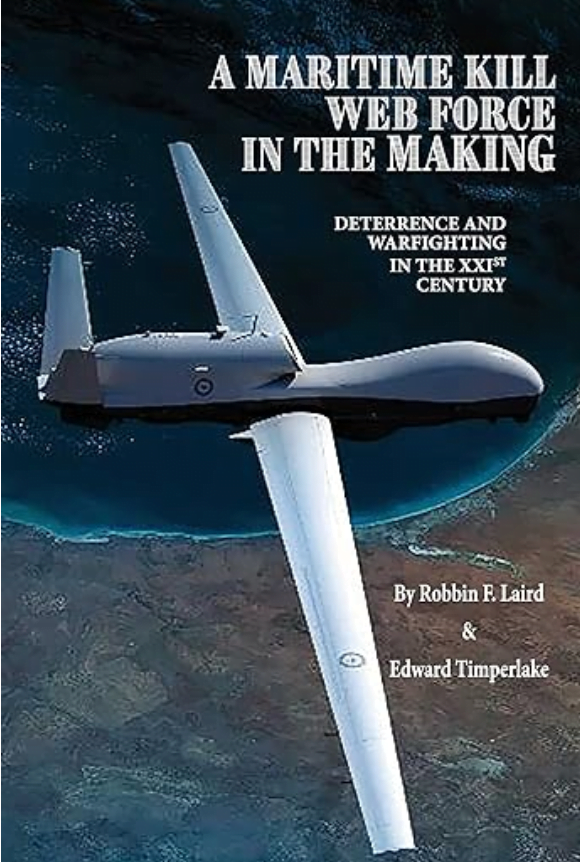During my recent visit to Australia in support of the 27 September Sir Richard Williams Foundation, I had a chance to meet again with Wing Commander Keirin Joyce and to discuss the impact of the Triton on the ISR-T enterprise in Australia.
Wing Commander Keirin Joyce has dealt with uncrewed systems within the combat force both as an Army and now as an Air Force officer.
Currently, he is Program Chief Engineer RPAS (MQ-4C Triton) at Royal Australian Air Force.
There has been recent criticism of Triton as being expensive and not part of the new generation of uncrewed systems, and therefore not really central to the way ahead set out in this year’s Defence Strategic Review. Joyce has extensive experience with a wide-range of UAVs and uncrewed systems and certainly agrees that Triton is not an example of the next generation attributable autonomous systems.
It is, after all, based on iterations of a 25-year-old GlobalHawk design.
But, it is the only aircraft that can do what it does and is a key element in the reshaping of the ISR-T enterprise in Australia, a reshaping which is considered central in the DSR. The Triton air system is the tip of the spear so to speak of the evolving ISR-T enterprise.
If one looks simply at the UAV, one misses the extensive ground systems being built to use its data along with the other key assets in the ISR-T emprise, such as P-8. The RAAF has been leading an effort for the ADF on building a new generation ground processing capability for the ADF to manage the enterprise data needed for the defense of Australia and empowering the multi-domain strike enterprise.
The recent Williams Foundation Seminar was entitled: “The Enterprise Requirements of an Australian Multi-Domain Strike Capability.” The focus of much of the seminar was on building new multi-domain strike capabilities, but the enterprise to do so requires advanced ISR-T capabilities.
The RAAF and the ADF have been working this challenge for more than a decade and Triton is embedded within the solution set. This lays down the foundation for further evolution in the years ahead for further advances in the ISR-T foundation to the multi-domain strike enterprise.
Wing Commander Joyce emphasized the importance and its contribution to the evolving ISR-T enterprise.
“It largely operates outside of the adversary’s weapons engagement zone and operates at a height where it can see deep into our areas of operation. Of course, if it is targeted, the range of our networked sensors will warn it and it has a jet engine to work an escape path.”
But the sensors on Triton are unique and multi-faceted and as such will provide unique capabilities for the ADF. He noted that if you contrast with the P-8 which flies low and is focused on ASW, the Triton is operating at much higher altitudes with an ability to see over much greater distances.
I pointed out that one of the challenges for any ISR-T system working the maritime domain is the need to find the wheat from the chaff, or to find real threats within the range of ships operating throughout an area of operation. Triton does have AIS and other sensors to add in this critical target discrimination problem.
Wing Commander Joyce added that “Triton will provide us with a level and amount of data we have never had before. And that interaction with our processing systems will allow us to grow our abilities in the ISR-T systems and prepare us for the inclusion of new systems in the future as well.”
I pointed out that the Australian debate and discussion about Triton had totally ignored the impact of the NATO AGS system and its role in the Ukraine war. When I worked for Secretary Wynne when he was the defence acquisition director, he recommended that NATO eschew the manned aircraft option and buy a UAV for its Air-Ground Surveillance system. Eventually, this happened and four variants of the Global Hawk were purchased and now operate out of Sigonella Air Base in Italy.
Wing Commander Joyce thought that was an important point to raise. He noted that “the NATO AGS system is operating in Europe at various altitudes and hoovering up ISR-T information useful in the conflict and beyond. Gaining information on the signature of adversary weapons and platforms is a key part of such a mission.”
Without doubt new generation maritime, land and air autonomous systems are coming. It is just that a future capability empowers no force: you have to fight with the force you have.
And Triton will make the ADF a more lethal and survivable force in the near to mid-term.
Shaping a Way Ahead for Remotely Piloted Air Systems: The Perspective of Wing Commander Keirin Joyce
Standing up the P-8/Triton Maritime Domain Strike Enterprise in Australia: Visiting RAAF Edinburgh


